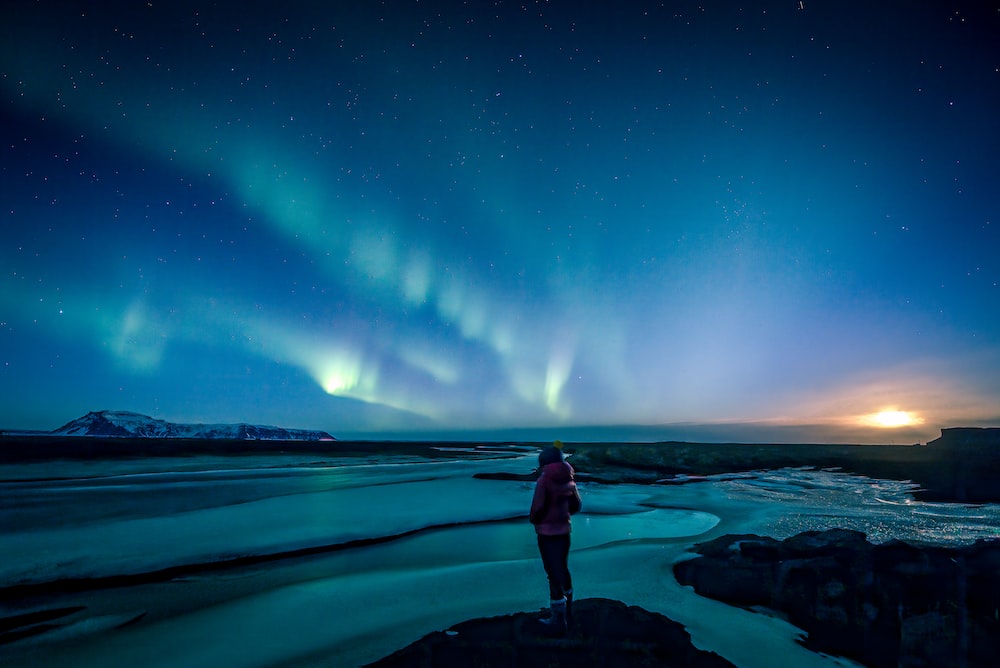Are you curious about the Northern Lights? Iceland is an amazing place to witness this beautiful phenomenon. With its dark winter skies, Iceland provides the perfect backdrop for the vibrant display of the Northern Lights. The best time to visit Iceland to see the Northern Lights is from mid-September to mid-April. During this season, the nights are longer, making it easier to stay up and watch the lights. Additionally, the temperature is milder during this time, making it more enjoyable for visitors. Whether you’re visiting for a few days or a few weeks, Iceland provides the perfect conditions to witness the majestic Northern Lights.

Experience the awe-inspiring beauty of Iceland’s Northern Lights, one of the most incredible natural phenomena in the world. From the comfort of your own home, you can take in the vibrant colors of the Aurora Borealis as they dance across the night sky. With the right weather conditions and a little bit of luck, you can view the Northern Lights in all their glory. Iceland’s pristine night sky is the perfect place to take in the wonder of the Northern Lights, and you won’t want to miss it.
Introduction

Are you curious about the Northern Lights? Iceland is an amazing place to witness this beautiful phenomenon. With its dark winter skies, Iceland provides the perfect backdrop for the vibrant display of the Northern Lights. The best time to visit Iceland to see the Northern Lights is from mid-September to mid-April. During this season, the nights are longer, making it easier to stay up and watch the lights. Additionally, the temperature is milder during this time, making it more enjoyable for visitors. Whether you’re visiting for a few days or a few weeks, Iceland provides the perfect conditions to witness the majestic Northern Lights.
Best Months to See the Northern Lights in Iceland
The northern lights are one of the most spectacular natural phenomena to witness. In Iceland, this natural wonder can be seen from September to April. The best time to view the lights is during the winter months when the skies are dark for longer periods of time. The northern lights are most visible during clear, dark nights, so it is best to plan your trip around the new moon. Also, be sure to dress warmly, as the cold temperatures in Iceland can get quite low during the winter season. With a bit of luck and planning, you can witness the natural beauty of the northern lights in Iceland.
Tips for Viewing the Northern Lights in Iceland

Iceland is one of the best places to see the Northern Lights and with a little bit of planning, you can maximize your chances of having a successful viewing experience. Before you go, check the Aurora forecast to determine the likelihood of the Northern Lights being visible during your stay. When you arrive, choose a location away from city lights and light pollution for optimal viewing. Make sure to dress warmly and bring a tripod to stabilize your camera. Lastly, be patient and enjoy the show!
Where to Find the Best Northern Lights Viewing Spots in Iceland
Iceland is one of the best places to witness the Northern Lights. With its clean air, dark skies and wide open spaces, it is the perfect destination to take in the spectacular show of dancing colors in the night sky. The best viewing spots for the Northern Lights in Iceland are typically away from the city lights and often at higher elevations, where the night sky is dark and the visibility is best. Popular spots include Thingvellir National Park, the Westfjords and the Eastfjords. For a truly exceptional experience, consider visiting Iceland during the winter solstice, when the nights are longest and the aurora borealis is often at its most vibrant.
Best Time of Day to View the Northern Lights in Iceland

Are you planning a trip to Iceland to see the spectacular Northern Lights? The best time of day to view the majestic aurora is during the night. From late August to mid-April, the dark winter nights provide the perfect opportunity to witness the magical Northern Lights. The best viewing times are usually between 9:00 pm and 2:00 am, when the sky is the darkest and the aurora borealis is most visible. However, it’s important to remember that the Northern Lights can never be predicted with certainty, so you never know when you might be in for a special surprise.
The Best Gear to Bring for Northern Lights Viewing in Iceland
Iceland is home to some of the most stunning Northern Lights displays. To make the most of your viewing experience, it is important to bring the right gear. From the best quality camera, to a tripod, and a headlamp, here are some of the items you should bring to Iceland for a night of Northern Lights viewing.
A quality camera is essential for capturing the incredible Northern Lights. Look for one with a fast shutter speed and wide angle lens, as well as a good sensor to capture the full spectrum of lights. Don’t forget to bring a tripod for steady shots and extra batteries.
Since Iceland can be cold during the winter months, be sure to dress in layers. Wear warm clothes and shoes, and bring a hat and gloves. A headlamp is also recommended, as it will help you to see in the dark while preserving your night vision.
How to Photograph the Northern Lights in Iceland

Photographing the Northern Lights in Iceland is an incredibly rewarding experience. It is a great way to capture the beauty of this natural phenomenon as it lights up the night sky with its vivid colors. To get the best photos, it is important to plan ahead and be patient. Start by researching the best possible location and time of year to photograph the Northern Lights in Iceland. Then, make sure to bring the right equipment, such as a camera with a wide-angle lens and a tripod to reduce camera shake. Finally, be prepared to wait until the Northern Lights appear and move quickly to adjust your camera settings as needed. With a little bit of planning and patience, you can capture amazing photos of the Northern Lights in Iceland.
The Best Weather Conditions for Northern Lights Viewing in Iceland
Viewing the Northern Lights in Iceland is a truly magical experience, and luckily the country offers some of the best conditions in the world for this phenomenon. The ideal environment to witness this natural phenomenon is during the winter months when the sky is dark and clear, and the air is still and cold. The best Northern Lights viewing locations in Iceland can be found in the countryside, away from the bright lights of the cities. For the best viewing experience, dress warmly and make sure to check the weather forecast before you go.
Unique Experiences to Have While Viewing the Northern Lights in Iceland

Iceland is one of the best places in the world to view the Northern Lights. A unique experience that only Iceland can offer is to take a trip to the Westfjords, where the night sky is free from light pollution and the sky is wide open for you to marvel at the beauty of the Northern Lights. From here, you can take a boat ride on the fjords and watch the Northern Lights dance across the sky. Additionally, you can take a dip in the Blue Lagoon and watch the Northern Lights shimmer in the night sky, or take a rugged snowmobile trip across Iceland and admire the Northern Lights in all its glory.
conclusion
Traveling to Iceland to see the Northern Lights is an experience like no other. It is a once in a lifetime opportunity to witness one of nature’s most spectacular displays of light. The best time to see the Northern Lights in Iceland is during the winter months, between October and March. During this time, the night sky is exceptionally dark and the air is often very still, providing the perfect conditions to see the vibrant display of the Aurora Borealis. If you are planning a trip to Iceland, make sure to plan it during the winter months to get the best possible chance of seeing the Northern Lights.

Some questions with answers
When is the best time to go to Iceland to see the Northern Lights?
The best time to visit Iceland to see the Northern Lights is late September to mid-April, when the nights are long and dark.
What should I wear when I go out to see the Northern Lights in Iceland?
When going out to see the Northern Lights in Iceland, it is important to wear warm, waterproof clothing as the nights can be cold and wet.
What is the most popular time to visit Iceland to see the Northern Lights?
The most popular time to visit Iceland to see the Northern Lights is from October to March.
How likely is it to see the Northern Lights in Iceland?
It is very likely to see the Northern Lights in Iceland during the peak periods from late September to mid-April. However, seeing the Northern Lights is not guaranteed.
Where is the best place to go in Iceland to see the Northern Lights?
The best place to go in Iceland to see the Northern Lights is anywhere away from light pollution, such as the countryside or highlands.
How long can the Northern Lights be seen in Iceland?
The Northern Lights can be seen in Iceland for up to a few hours each night, depending on the weather conditions.
What is the best activity to do while waiting for the Northern Lights?
The best activity to do while waiting for the Northern Lights is to explore some of Iceland's natural attractions, such as glaciers, volcanoes, geysers, and waterfalls.
What is the best way to find out if the Northern Lights are visible in Iceland?
The best way to find out if the Northern Lights are visible in Iceland is to check the Aurora forecast, which is updated several times a day.
What type of weather is required to see the Northern Lights in Iceland?
Clear, dark skies are required to see the Northern Lights in Iceland, which means avoiding cloudy and rainy nights.
What should be taken into account when planning a trip to Iceland to see the Northern Lights?
When planning a trip to Iceland to see the Northern Lights, it is important to take into account the weather forecast, the length of nights, and the cost of travel.
